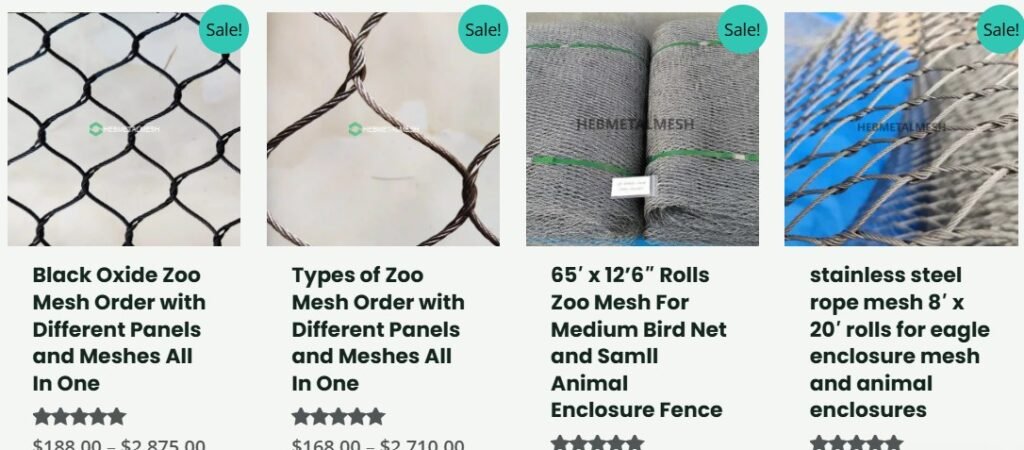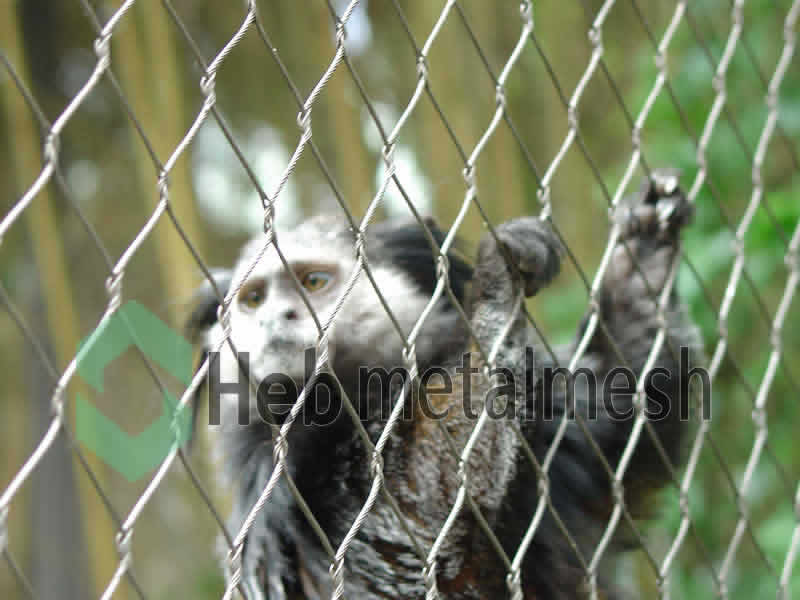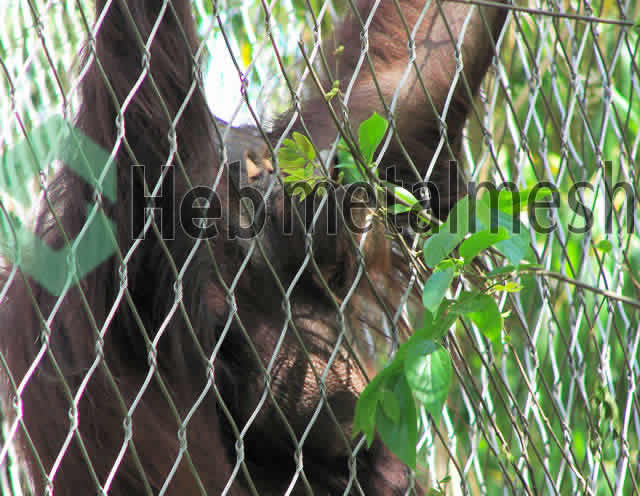Introduction to Enclosure Mesh
Enclosure mesh serves as a crucial component in various applications aimed at protecting wildlife and maintaining the integrity of habitats. At its core, enclosure mesh is a barrier made from a network of interwoven materials, designed to provide a secure environment while allowing for airflow and visibility. Its uses span across different sectors, including wildlife conservation, agriculture, and urban development, showcasing its versatility.
The materials utilized for creating enclosure mesh vary, but stainless steel is increasingly favored due to its superior characteristics. Specifically, stainless steel wire rope is often employed in the production of enclosure mesh, providing unmatched durability and resistance to various environmental factors. Unlike other materials such as plastic or galvanized steel, stainless steel boasts exceptional corrosion resistance, which is particularly advantageous in outdoor settings where exposure to moisture and other harsh conditions is a concern.
Moreover, the strength of stainless steel wire rope contributes to the longevity of enclosure mesh, ensuring that it can withstand harsh weather conditions, physical stress, and potential wildlife interactions. As such, the choice of enclosure mesh material is paramount in maintaining an effective protective boundary, particularly when developing safe enclosures for wildlife. The inherent properties of stainless steel also contribute to the aesthetic appeal of the mesh, allowing it to blend seamlessly into natural surroundings while fulfilling its functional role.
In conclusion, the significance of enclosure mesh, especially when crafted from stainless steel wire rope, cannot be overstated. Its robust nature, along with its multifunctionality, positions it as a preferred solution for various applications related to wildlife protection and habitat conservation.
Benefits of Stainless Steel 304 in Enclosure Mesh
Stainless steel 304 is a widely acclaimed material for enclosure mesh, renowned for its exceptional properties that cater to a variety of wildlife applications. One of the primary advantages of stainless steel 304 is its impressive corrosion resistance. This characteristic is crucial for enclosures exposed to outdoor environments, where they are often subjected to moisture, varying temperatures, and pollutants. The ability of stainless steel 304 to withstand such elements without degrading over time ensures the integrity of the enclosure mesh, promoting prolonged durability and reliability.
In addition to corrosion resistance, stainless steel 304 possesses significant strength and structural integrity, making it an ideal choice for enclosure mesh designed to contain wildlife safely. The tensile strength of this material allows it to resist damage from impact and stress, thus maintaining functionality even when subjected to the natural behaviors of animals. For instance, enclosures housing larger or more active species benefit from the robustness of stainless steel 304, as it effectively prevents breaches caused by digging or climbing.
Longevity is another standout feature of stainless steel 304 in enclosure mesh applications. Its resistance to wear and tear means that facilities can expect a longer lifespan without frequent replacements. This quality leads to long-term cost savings and reduced maintenance efforts, which are critical factors for wildlife sanctuaries and conservation projects operating under budget constraints. Furthermore, in diverse environments—from humid coastal regions to dry inland areas—stainless steel 304 maintains its performance, contributing to the overall safety and effectiveness of animal enclosures.
Ultimately, the combination of corrosion resistance, strength, and longevity makes stainless steel 304 the optimal choice for constructing enclosure mesh that ensures the well-being of wildlife. Its ability to perform reliably under various environmental conditions highlights its significance in wildlife management and conservation efforts.
Applications in Wild Animal Fencing

Stainless steel enclosure mesh has emerged as a vital component in the fencing of wild animals, offering robust protection and safety in various wildlife applications. The durability and resilience afforded by stainless steel make it an optimal choice for constructing enclosures aimed at preserving natural habitats, while simultaneously ensuring the safety of both wildlife and the public. One of the primary benefits of utilizing stainless steel mesh is its resistance to environmental elements, ensuring long-term performance without the need for frequent replacements.
In designing effective wild animal fencing, considerations such as height, tensioning, and overall enclosure structure play critical roles. The height of the mesh fence can deter larger species from jumping over, while the appropriate tensioning is essential to prevent any sagging that could compromise the integrity of the enclosure. For instance, a successful installation in a national park demonstrated how a 10-foot tall stainless steel enclosure mesh was integral in keeping elk safely contained while allowing for safe public viewing.
Moreover, case studies underline the importance of proper installation techniques, such as the incorporation of secure bases and top extensions to thwart wildlife from burrowing or climbing over the fence. It is also noteworthy that these enclosures can be designed to maintain aesthetic aspects, blending with natural scenery while fulfilling their protective functions.
Not only does the use of stainless steel enclosure mesh ensure the well-being of wildlife by preventing unwanted escapes, but it also safeguards public areas from potential wildlife interactions that may lead to hazardous situations. Therefore, the application of enclosure mesh in wild animal fencing stands as an exemplary solution for wildlife conservation efforts.
Designing Zoo Enclosures with Enclosure Mesh
In the context of modern zoo enclosures, the significance of utilizing stainless steel enclosure mesh cannot be overstated. This versatile material not only ensures the safety and security of the animals but also plays a crucial role in enhancing the aesthetic appeal of the habitat. When designing enclosures, professionals must consider various factors, including visibility, safety, and the promotion of a naturalistic environment.
Visibility for spectators is a key consideration in the design of zoo enclosures. Stainless steel enclosure mesh offers an unobtrusive barrier that allows for excellent sightlines, enabling visitors to observe animals without disrupting their natural behaviors. The mesh design minimizes the impact on the visual experience, as it can be crafted to be nearly invisible at a distance. By maintaining a clear view, enclosures enhance the educational experience, allowing guests to engage meaningfully with wildlife while ensuring that animals remain protected.
Another critical aspect to contemplate is ventilation and the overall comfort of the animals. Stainless steel mesh is known for its breathability, allowing for adequate air circulation within the enclosure. This feature helps maintain a stable environment that is essential for the well-being of the inhabitants. Furthermore, the material can be used creatively to mimic natural habitats, assisting in the creation of spaces that feel more organic and less confining. Effective design approaches utilize enclosure mesh to craft climbing structures and barriers that blend seamlessly into landscaped settings, promoting both enrichment and mental stimulation for the animals.
Moreover, incorporating enclosure mesh into zoo design facilitates ongoing maintenance and longevity, as the stainless steel is resistant to corrosion and wear. This durability ensures that the enclosures remain safe and visually appealing over time. By leveraging the benefits of stainless steel enclosure mesh, zoos can create engaging environments that prioritize the safety of animals and the enjoyment of visitors.
Creating Safe Bird Aviaries
Stainless steel enclosure mesh plays a crucial role in the construction of bird aviaries, and its benefits significantly enhance the well-being of various bird species. One essential factor to consider when designing aviaries is the size of the mesh openings. The mesh must be fine enough to prevent smaller birds, such as finches or canaries, from escaping while still allowing for adequate ventilation and exposure to sunlight. A mesh size that safeguards against predators, such as cats or hawks, is also vital to ensure the birds’ safety.
Visibility is another critical element when incorporating stainless steel enclosure mesh into bird aviaries. The use of a transparent or semi-transparent material allows for clear sightlines, which can reduce stress levels in birds. They are often more comfortable in an environment where they can see their surroundings. The ability to observe outside activity and other birds can contribute to a more enriched living space. For example, species that thrive in social settings benefit from having a clear view of their aviary companions, as well as any wildlife that may come into their environment.
Additionally, stainless steel enclosure mesh offers durable protection against potential threats, while also allowing for interaction with nature. The strong yet flexible nature of stainless steel makes it an ideal choice for bird aviaries, as it resists corrosion and wear, ensuring longevity. As caretakers, it is also essential to foster a balanced environment that considers the needs of both the birds and the wildlife around them. Proper maintenance of the mesh and aviary setup promotes a healthy ecosystem where birds can thrive safely. Various bird species, from parrots to doves, greatly benefit from well-constructed aviaries that incorporate stainless steel enclosure mesh, providing a harmonious balance that enhances their quality of life.
Color Options and Aesthetic Considerations
When it comes to selecting enclosure mesh for wildlife applications, aesthetics play a significant role alongside functionality and safety. The available color options, particularly natural and black oxide finishes, are essential factors that contribute to both the visual appeal of the enclosure and its potential impact on wildlife behavior and visitor experiences.
Natural finishes tend to blend seamlessly with various environments, including forested areas, wetlands, and grasslands. This characteristic allows the enclosure mesh to integrate more naturally into the wildlife habitat, thereby minimizing the disruption to the surroundings. This visual uniformity can create a more serene experience for visitors, as they are able to appreciate the wildlife without the distraction of overtly artificial structures.
On the other hand, black oxide finishes offer a sleek and modern alternative that can add a contemporary touch to wildlife enclosures situated in urban or landscaped settings. This color option not only enhances the visual appeal but also serves practical purposes, as the darker tone can help reduce glare and reflections. Such characteristics may encourage more natural behaviors among the animals housed within, as they may feel less threatened by overt human presence.
In terms of wildlife behavior, the color of the enclosure mesh can have psychological effects, both on animals and visitors. Subtle hues may foster a sense of safety in animals, while more neutral colors can be less intrusive for observers. Furthermore, a well-chosen color can enhance engagement and facilitate educational opportunities for visitors by ensuring that the enclosure remains visually appealing and unobtrusive.
Ultimately, the decision regarding the color of enclosure mesh not only reflects aesthetic considerations but also influences the wellbeing of wildlife and the overall experience for those engaging with these habitats.
Maintenance of Stainless Steel Enclosure Mesh
Maintaining stainless steel enclosure mesh is crucial for ensuring its longevity and functionality in wildlife applications. Given the diverse environments where this mesh is implemented, routine care can significantly enhance its performance and durability. One of the first steps in maintenance is regular cleaning to prevent the buildup of dirt, debris, or organic matter that could compromise its integrity. Using a mild detergent and water, one can gently scrub the surface with a non-abrasive cloth or soft brush, ensuring that no harmful chemicals are introduced that might corrode the mesh.
In addition to cleaning, inspection for wear and damage should be an integral part of the maintenance routine. This involves checking the mesh at regular intervals for signs of rust, tears, or any deformation that may have occurred due to environmental pressures. The nature of stainless steel makes it resistant to corrosion, but it is not entirely immune, especially if exposed to harsh conditions. Inspecting the fasteners and installation points is equally important to ensure that the enclosure remains secure and effective in containing wildlife.
Furthermore, securing the installation over time is vital. This can involve tightening loose fittings and replacing any damaged or corroded parts to maintain the effectiveness of the stainless steel enclosure mesh. The mesh should be re-evaluated periodically, particularly in high-stress environments or areas with significant wildlife activity, to ensure that it continues to function as intended.
In summary, proactive and systematic maintenance practices, including cleaning, inspection, and securing installations, are key to maximizing the lifespan and performance of stainless steel enclosure mesh in wildlife applications. Regular upkeep can prevent minor issues from escalating and ensure optimal functionality over time.
Addressing Concerns about Enclosure Safety
When it comes to wildlife applications, the safety of enclosure mesh is a significant concern for many. Stainless steel enclosure mesh has gained prominence as a reliable solution due to its robust characteristics and durability. It is crucial to recognize that not all enclosure mesh is created equal; stainless steel stands out for several reasons. First and foremost, this material is inherently strong, providing resistance against various environmental stresses, including harsh weather conditions, making it suitable for both indoor and outdoor wildlife applications.
One common myth is that wildlife can easily break through or damage mesh enclosures. However, stainless steel enclosure mesh is specifically designed to withstand significant pressure and force. Its robustness ensures that wildlife cannot escape easily, while also protecting them from external threats. Moreover, stainless steel is resistant to corrosion and rust, contributing to its longevity. This means that over time, it maintains its structural integrity, offering continued safety for both animals and humans alike.
Additionally, safety standards are paramount when integrating enclosure mesh into public spaces. Stainless steel options meet or exceed the required safety regulations, thus ensuring that they are safe for use in wildlife parks, zoos, and other public areas. By complying with industry standards, this mesh provides peace of mind to both wildlife specialists and the general public. Therefore, the use of stainless steel enclosure mesh should be viewed as a commitment to safety and animal welfare, addressing any concerns regarding escape or injury.
Ultimately, choosing reliable materials such as stainless steel for enclosures not only enhances the protection of wildlife but also promotes a safer environment for communities. By dispelling myths and addressing concerns around enclosure safety, individuals can feel confident in the effectiveness of stainless steel mesh in wildlife applications.
Conclusion and Future of Enclosure Mesh
Stainless steel enclosure mesh has proven to be an invaluable asset in various wildlife applications, providing solutions that are not only durable but also environmentally friendly. Throughout this article, we have explored the benefits of using stainless steel, including its corrosion resistance, strength, and long lifespan. These features make it ideal for protecting wildlife while ensuring minimal disturbance to their natural habitats. As conservation efforts continue to evolve, the demand for more sustainable solutions in wildlife management will only grow, highlighting the essential role that enclosure mesh can play.
The versatility of stainless steel enclosure mesh extends beyond its immediate applications, offering exciting opportunities for future advancements. In wildlife refuges, for example, enclosure mesh can be utilized as barriers for endangered species, providing a safe haven while allowing for natural behaviors. Furthermore, advancements in mesh technology could lead to the development of more customizable designs tailored to specific wildlife needs, facilitating better integration with various ecosystems.
As the conversation around sustainable design practices strengthens, enclosure mesh is poised to become a staple in efforts aimed at wildlife conservation. Its recyclability and longevity ensure that it aligns with environmental goals, making it an attractive choice for architects and designers who prioritize sustainability in their projects. The future may see innovative applications of enclosure mesh in urban design, where it can serve as a crucial element in creating green spaces that are safe for both wildlife and human inhabitants.
Encouraging the ongoing exploration of stainless steel mesh solutions will be vital as we navigate the complexities of wildlife protection and habitat preservation. By embracing these materials in future projects, we can contribute to a balance between human development and wildlife conservation, ultimately fostering a healthier relationship between nature and urban life.


